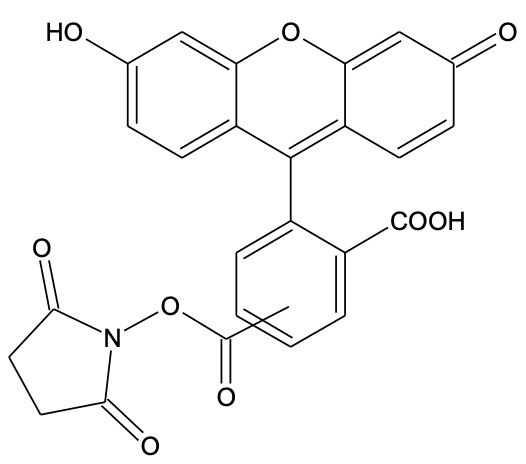5(6)-FAM, SE [5-(and-6)-Carboxyfluorescein, succinimidyl ester] *Mixed isomers*
商品编号: 110-100mg;110-1g
800元/100mg;4150元/1g
产品介绍
Succinimidyl esters are proven to be the best reagents for amine modifications because the amide bonds that are formed are essentially identical to, and as stable as the natural peptide bonds. These reagents are generally stable and show good reactivity and selectivity with aliphatic amines. There are few factors that need be considered when SE compounds are used for conjugation reaction:
1). Solvents:For the most part, reactive dyes are hydrophobic molecules and should be dissolved in anhydrous dimethylformamide (DMF) or dimethylsulfoxide (DMSO).
2). Reaction pH:The labeling reactions of amines with succinimidyl esters are strongly pH dependent. Amine-reactive reagents react with non-protonated aliphatic amine groups, including the terminal amines of proteins and the e-amino groups of lysines. Thus amine acylation reactions are usually carried out above pH 7.5. Protein modifications by succinimidyl esters can typically be done at pH 7.5-8.5, whereas isothiocyanates may require a pH 9.0-10.0 for optimal conjugations.
3).Reaction Buffers:Buffers that contain free amines such as Tris and glycine and thiol compounds must be avoided when using an amine-reactive reagent. Ammonium salts (such as ammonium sulfate and ammonium acetate) that are widely used for protein precipitation must also be removed (such as viadinlysis) before performing dye conjugations.
4). Reaction Temperature:Most conjugations are done at room temperature. However, either elevated or reduced temperature may be required for a particular labeling reaction.
5(6)-FAM, SE [5-(and-6)-Carboxyfluorescein, succinimidyl ester]
1. Hahn M, et al. (2001). Influence of fluorophore dye labels on the migration behavior of polymerase chain reaction-amplified short tandem repeats during denaturing capillary electrophoresis. Electrophoresis22, 2691-700.
2. Sanders SJ (2000). Factor V Leiden genotyping using real-time fluorescent polymerase chain reaction. Mol Cell Probes14, 249-53.
3. Brandis JW (1999). Dye structure affects Taq DNA polymerase terminator selectivity. Nucleic Acids Res27, 1912-8.
注意事项:
1) 本公司所有产品仅限于专业人员用于生命科学研究,不得用于临床诊断或治疗,不得用于食品或药品,不得存放于普通住宅。
2) 本公司所有产品必须由合格专业技术人员操作同时佩戴口罩/手套/实验服并遵守生物实验室安全操作规程!
产品参数
| Name |
5(6)-FAM, SE [5-(and-6)-Carboxyfluorescein, succinimidyl ester] *Mixed isomers* |
| CAT# |
110-100mg;110-1g |
CAS# |
117548-22-8 |
| Storage# |
-20°C Sealed & desiccated & Minimized light exposure |
Shelf Life# |
24 months |
| Ex(nm)# |
495 |
Em(nm)# |
517 |
| MW# |
473.39 |
Solvent# |
DMF/DMSO |
| Name |
5(6)-FAM, SE [5-(and-6)-Carboxyfluorescein, succinimidyl ester] *Mixed isomers* |
| CAT# |
110-100mg;110-1g |
| CAS# |
117548-22-8 |
| Storage# |
-20°C Sealed & desiccated & Minimized light exposure |
| Shelf Life# |
24 months |
| Ex(nm)# |
495 |
| Em(nm)# |
517 |
| MW# |
473.39 |
| Solvent# |
DMF/DMSO |


![5(6)-FAM, SE [5-(and-6)-Carboxyfluorescein, succinimidyl ester] *Mixed isomers*详细说明书](/Public/Home/images/pic52.png) 详细说明书
详细说明书![5(6)-FAM, SE [5-(and-6)-Carboxyfluorescein, succinimidyl ester] *Mixed isomers*技术资料](/Public/Home/images/pic53.png) 技术资料
技术资料




